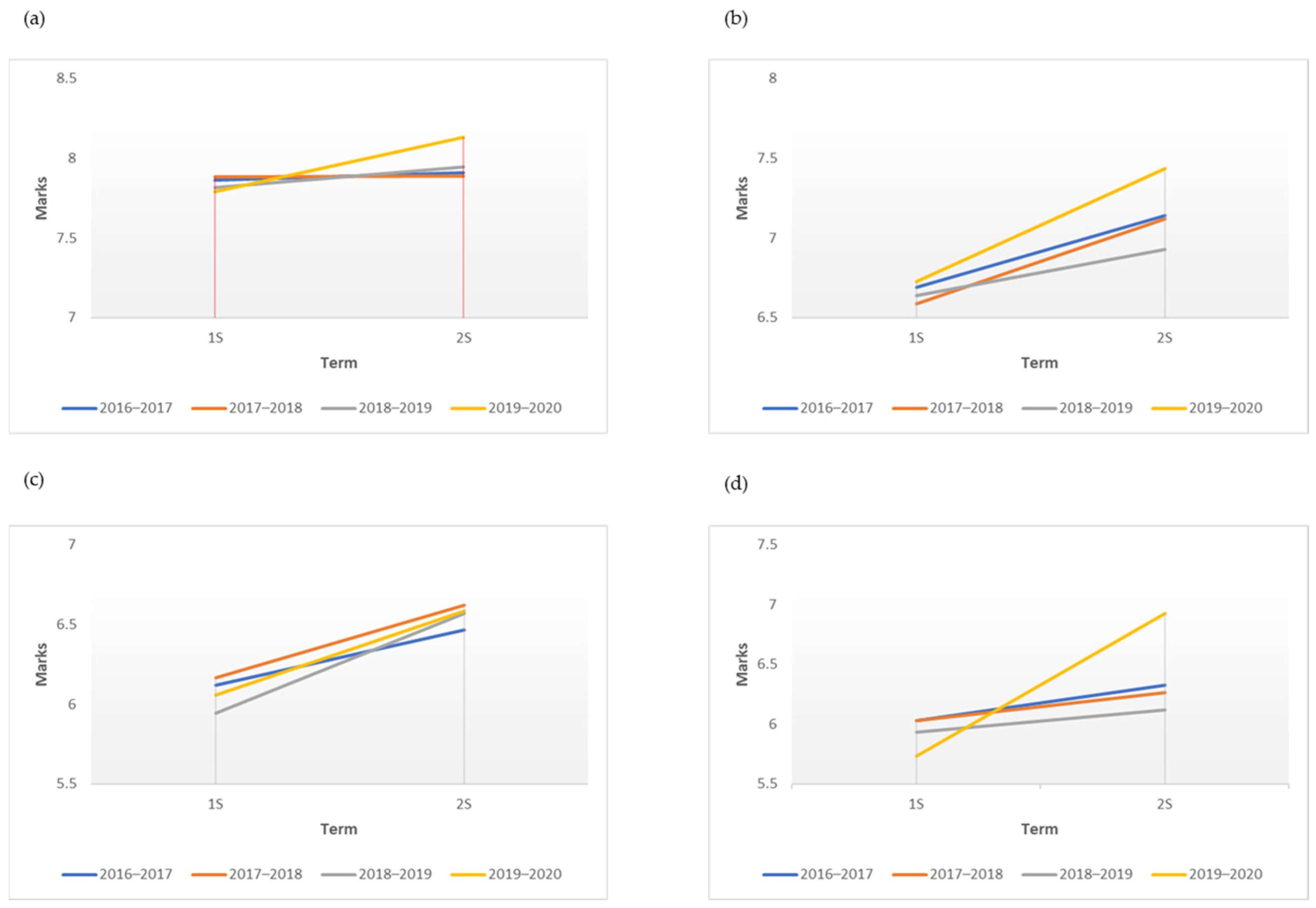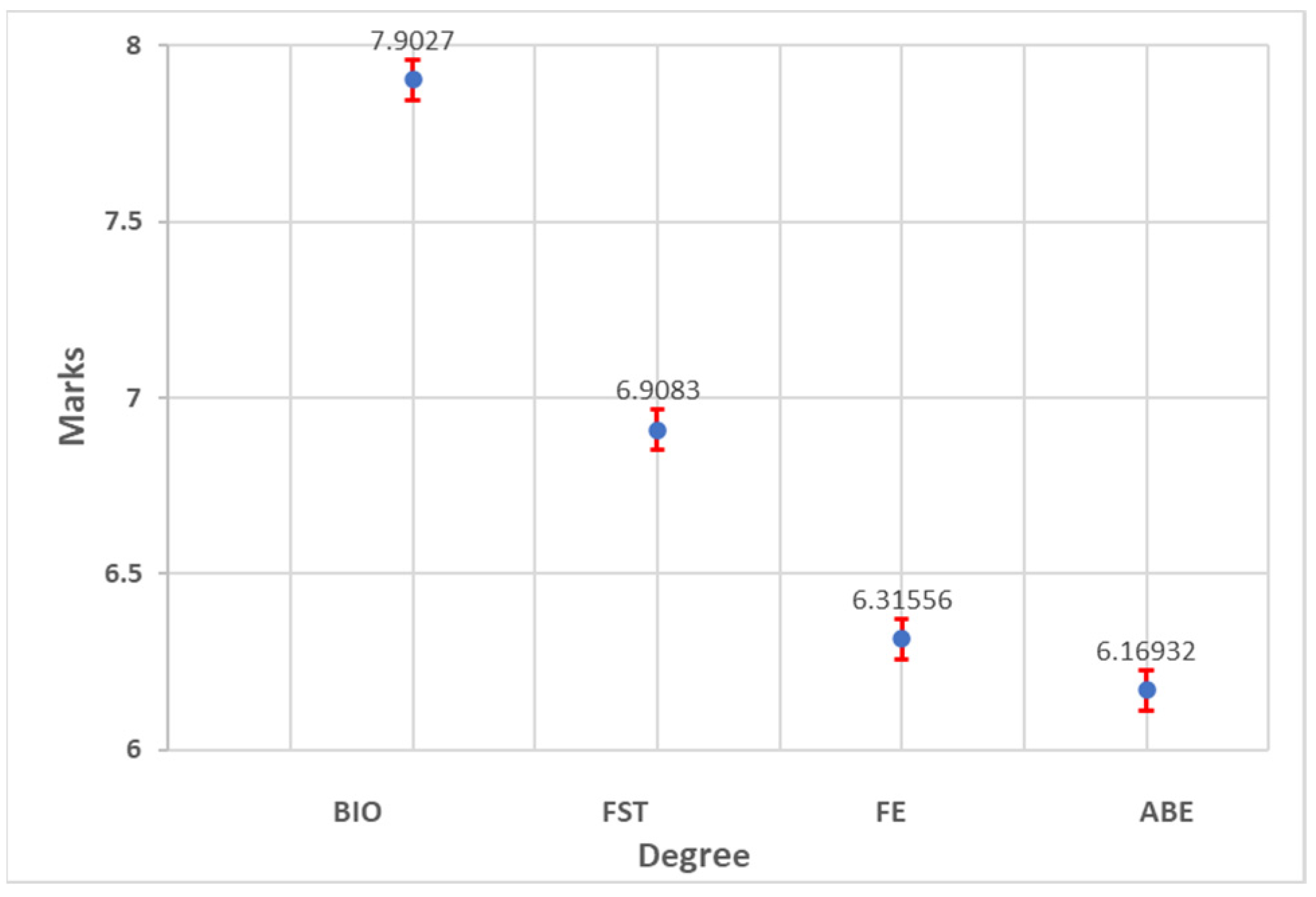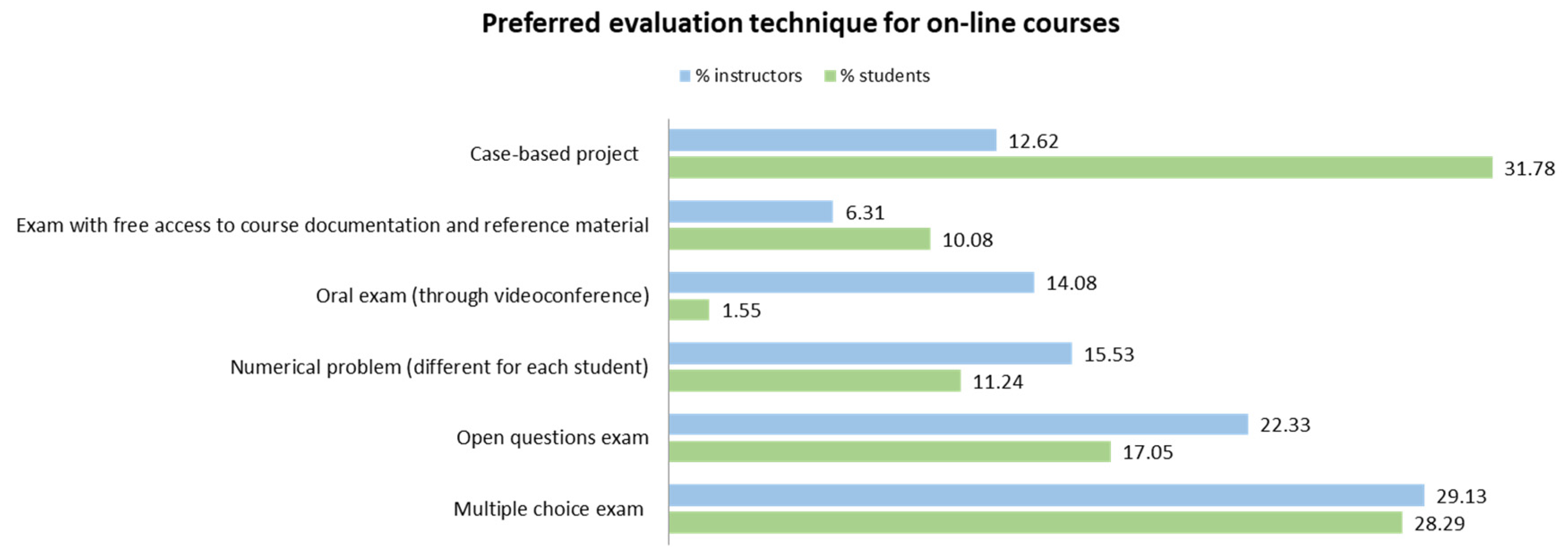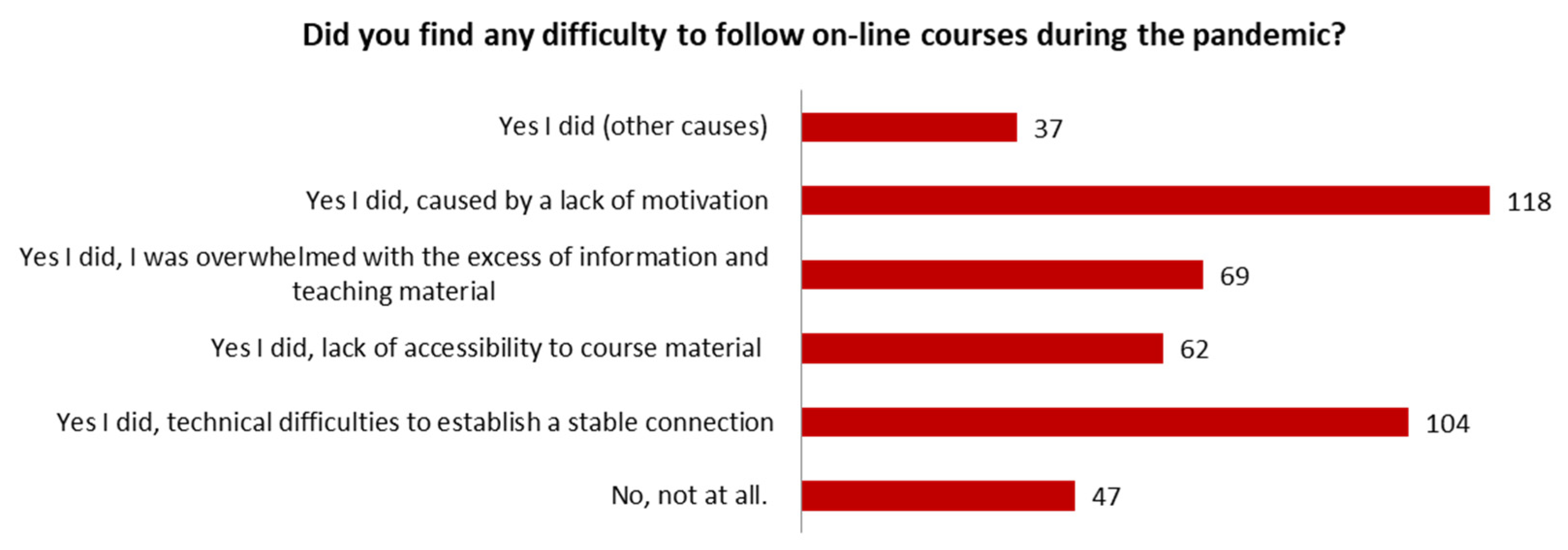1. Introduction
To control the spread of the COVID-19 epidemic, a state of alarm was declared in Spain from 14 March to 21 June 2020. During this period, people were confined to their homes and only essential activities were allowed in person. Similar measures were rolled out in many other countries at the same time. In this work, we aim to study the first impact of the COVID-19 crisis on the results obtained by the School of Agricultural Engineering and Environment students at the Universitat Politècnica de València (Spain). Moreover, instructors and students were surveyed on teaching methodologies and evaluation modalities to compilate their preferences just at the end of that period, corresponding to the 2019–2020 spring semester.
At that time, educational institutions were temporarily closed by most governments [
1]. The traditional face-to-face (hereinafter FtoF) courses offered by universities all over the world all at once had to migrate somehow onto an online (hereinafter OL) version using whichever technology that faculty were familiar with at the time [
2]. Preserving educational continuity while maintaining a high level of quality has proven to be a significant issue [
3]. Universities had to pass from FtoF to OL education and they were not prepared for such a sudden change at the beginning of the pandemic [
4]. In this sense, some authors have pointed out the necessity of distinguishing between learning activities planned and designed to take place online from the start, and the temporary transfer of the type of instructional delivery due to circumstances imposed by COVID-19, dubbed emergency remote teaching (hereinafter ERT) [
5].
Teaching requires a certain pedagogical content knowledge as a general rule [
6], i.e., the integration of the subject matter knowledge contents with the pedagogical knowledge teaching methodologies and strategies for the purposes of adapting the learning process to the students’ interest and ability. According to Rapanta et al. [
7], OL teaching would require a specific pedagogical content knowledge different from that of the FtoF, due to the irruption of a new component, information and communication technologies [
8], which represented a huge challenge for the higher education community that had almost shifted to ERT overnight. In fact, the concept of “technological pedagogical content knowledge” (known as TPaCK), which comprises different elements including the technological content knowledge, has emerged because of the continued development of innovative technologies and their increased integration in educational practices, gaining importance during the COVID-19 epidemic. Beyond the technical barriers and occasional work overload which faculty had to face (the need to learn new software, transform teaching resources to be used online, balance their new family life and work in the same space, etc.), ERT had a profound impact on the emotional well-being of teachers. In a recent university survey conducted in Italy, Casacchia et al. [
9] reported physiological difficulties, such as the discomfort of speaking in the void or the absence of eye contact, which ended up expressing themselves in the form of different emotional disorders, such as depressive symptoms, difficulty concentrating or a loss of energy. Odriozola-González et al. [
10] reported anxiety, depression and stress in another university survey on the lockdown period conducted in Spain, those effects being even greater in students than in faculty and staff.
Specific barriers have been profusely described when comparing OL teaching to FtoF instruction delivery. Roddy et al. [
8] mark out perceived isolation, work and family commitments, confusion with contents, poor academic performance, technical issues, or lack of motivation as the main barriers. The COVID-19 pandemic lockdown forced both students and faculty to work and learn from home when their broadband connectivity quality, access to appropriate equipment (PC, laptop, etc.), digital literacy skills or home study environment was not adequate for such purposes [
11]. As regards the broadband connectivity, in a study carried out in Ireland, Cullinan et al. [
11] pointed out that almost 17% of higher education students suffered from poor broadband coverage during spring 2020, with significant differences linked to geographical issues and their socioeconomic level.
Some studies have pointed to a poor performance of OL students compared to their FtoF peers. In an extensive survey carried out at a university in the Southwestern United States, McPartlan et al. [
12] used the Eccles expectancy-value theory of motivation [
13] to demonstrate that differences in the motivation, behavior, and performance of OL students could be explained by using not only demographic variables (age, race, gender, and socioeconomic status) but also other student needs, such as flexibility, cost, or family and employment obligations. However, those differences were not based on ERT but on a free choice and might not be adequate when ERT is applied. In this regard, Patricia Aguilera-Hermida [
14] conducted an exploratory questionnaire collected from 270 students at a public university on the East Coast of the United States with the aim of assessing the acceptance of ERT during the stay-at-home order, concluding that students preferred FtoF instructional delivery, although attitude towards the learning delivery method, motivation, self-efficacy and cognitive engagement were key factors. On a positive note, the study confirmed that students used more online educational tools after ERT than before. Regarding the outcomes, contradictory results can be found when comparing FtoF to ERT. Gonzalez et al. [
15] conducted research into student performance, comparing the spring semester of 2020 with the outcomes of previous academic years using three subjects from two different program degrees involving 458 students at a public university in Spain, in which they found a significant positive effect on grades. However, Talsma et al. [
16] compared self-efficacy beliefs (how 85 Australian students thought ERT would impact their performance in one subject) to both subject grades at the end of the ERT semester 2020 and to grades of the same group in 2019, concluding that no significant differences existed. It seems that many factors have influenced students’ performance (subject, group, socio-economic characteristics, etc.), thus it is important to study each context separately.
During the ERT period, faculty drew upon different learning solutions and innovations for the instruction delivery without a coordinated design plan. Methods of emergency remote teaching differed from college to college, leading to students having varying perceptions of the process and effectiveness of learning [
17]. Synchronous/asynchronous online learning or a combination of them (blended learning) along with a wide variety of teaching (projects, case studies, online office hours, etc.) and evaluation (open response exam, multiple choice exam, tasks, etc.) techniques were employed by faculty and the preferences of students and faculty are an issue which deserves attention.
To date, many studies have reported the effect of COVID-19 on academia and students, seeking potential measures which may help alleviate the negative impact of the crisis on higher education and promote future smoother transitions from FtoF to OL teaching (reviewed in [
18]). In order to contribute to this search through a case of study at the School of Agricultural Engineering and Environment of the Universitat Politècnica de València, we considered the following research questions (hereinafter RQ):
- RQ1.
Could the special scenario lived during spring semester lockdown of 2020 have any effect on the students’ performance at the School of Agricultural Engineering and Environment located in the third largest city in Spain?
- RQ2.
In the event of answering yes to RQ1, do those differences depend on the degree program, year, or their interaction?
- RQ3.
Just at the end of the ERT, did students and faculty express similar preferences on either the teaching or evaluation methodologies developed?
No society is exempt from natural hazards. A global pandemic is a novel situation without precedent in recent times, although more frequent in the not-so-distant past. However, other natural disasters, such as floods, volcanic eruptions, hurricanes, heat, and cold waves, etc. may produce situations that require a new transition to ERT for a short period. A profound understanding of this period and the lessons learned now should lead to colleges being prepared to face new episodes.
2. Materials and Methods
2.1. Context of the Study
The School of Agricultural Engineering and Environment (ETSIAMN) is located in the Universitat Politècnica de València (UPV, Valencia, Spain). For the last two decades, the UPV and, in particular ETSIAMN, have been supporting the incorporation of new information and communication technologies (ICT) in the learning and teaching processes of both bachelor’s and master’s degrees. However, it has only been now during the COVID-19 pandemic in the second semester of 2020 when distance learning has had to be imposed as the only teaching methodology throughout the University. This has entailed a great deal of effort from the entire university community, both teachers and students and even administration staff.
In UPV, the academic year starts in September and finishes in July. Thus, each academic year covers two calendar years (i.e., academic year 2016–2017 covers from September 2016 until July 2017). The first semester lasts from September to January and the second semester from February to July. Four bachelor’s degrees (four academic years) are taught in ETSIAMN: (i) Biotechnology, (ii) Food Science and Technology, (iii) Forestry Engineering, and (iv) Agricultural and Biological Engineering. It is important to note that both Engineering courses meet the requirements of the Accreditation Board for Engineering and Technology (ABET). The student profile differs depending on the degree and academic year; thus, an in-depth analysis is proposed in order to determine the influence of the COVID-19 crisis on student performance (RQ1 and RQ2). On the other hand, three master’s degrees (two academic years) are also taught in ETSIAMN: (i) Agricultural Engineering, (ii) Forestry Engineering, and (iii) Oenology. Most of the master’s students have not studied bachelor’s degrees in ETSIAMN. They come from different national and international universities. It should be pointed out that the vast majority of teachers in ETSIAMN participate in more than one degree and most of them teach in both the bachelor’s and master’s programs; thus, their perceptions as regards the teaching methodologies employed during the period in question cannot be distinguished. For that reason, a study into the perceptions of students and faculty in ETSIAMN was developed in order to answer RQ3.
This study has been performed by the Executive Board of the ETSIAMN, including the Director and the Deputy Directors.
2.2. Analysis of Student Performance
In order to answer RQ1 and RQ2, the averages of the marks corresponding to the three academic years preceding the COVID-19 crisis (2016–2017, 2017–2018 and 2018–2019) were compared to those obtained in 2019–2020 (when the lockdown occurred during the second semester) for all the subjects in the four bachelor’s degrees and for the two semesters of each academic year. During 2019–2020, OL exams were performed by the students through the PoliformaT platform, which is based on the Sakai environment, and developed at the UPV as a teaching support tool. Although no biometric access control was used to access to the online exams because of protection of image rights, specific identification with ID and password was required to log in the online exams. Moreover, Teams (Office 365) connections during the exam performances were requested so that lecturers could virtually supervise the students’ actions by asking them to switch on the cameras at any moment. These measures somehow guarantee the quality of the OL exams.
The anonymous aggregated data corresponding to marks obtained by the total student population were obtained from UPV databases for each course, subject, academic year and bachelor’s degree. For each academic year and bachelor’s degree, the average mark was obtained from the average mark of all the subjects from each course.
A total of 12,811 marks obtained by the Biotechnology degree students corresponding to three academic years (2016–2017, 2017–2018, and 2018–2019), and 4041 marks corresponding to the COVID-19 2019–2020 academic year were analyzed. In a similar manner, a total of 11,851 marks obtained by the Food Science and Technology degree students, corresponding to the four academic years (2016–2017, 2017–2018, 2018–2019, and the COVID-19 year of 2019–2020) and both semesters were studied. A similar approach was performed for the two engineering degrees offered at ETSIAMN, that is, Forestry Engineering and Agricultural and Biological Engineering. Starting with the first engineering degree, a total of 5331 marks were included in the analysis. As for the Agricultural and Biological Engineering degree, a total of 8514 marks corresponding to the first semester, and 7940 marks obtained by students during the second semester were used to determine frequencies, tests of homogeneities, and to perform an ANOVA analysis.
For each degree course, the statistical analysis of the results was carried out using a chi-square homogeneity test on the grades obtained by the students on a categorical grading scale (No-show, Failed, Pass C, B, A and A+), to conclude whether there was the same distribution of grades in 2016–2019 and 2019–2020, and it was carried out in both semesters separately to detect the effect of COVID-19. To complete the analysis, an ANOVA was also performed, in which the response variable considered was the average mark (quantitative variable) obtained by the students in each subject and, as explanatory factors, the course level, the semester and the academic year of the subjects in order to study the effect of and the interactions between these factors on the response. It should be noted that the interaction of semester and academic year provides a good test to study the effect of COVID-19 on grades.
2.3. Analysis of Student and Faculty Preferences
For the purpose of answering RQ3, an anonymous survey was designed in order to obtain and analyze the opinion of students and faculty regarding the teaching and evaluation methodologies during the COVID-19 pandemic, just at the end of the 2019–2020 spring semester.
The data used in the study come from two anonymous surveys carried out in July 2020 on the ETSIAMN teaching staff and students. Those surveys were performed telematically with the help of the formerly mentioned PoliformaT platform. The PoliformaT learning platform allows teachers and students to share information about subjects and uses various management tools: repository of resources, tasks, content, online exams, news, calendars, chat, internal mail, discussion forums, wiki spaces and staff for students. In particular, the PoliformaT exam tool is highly functional and configurable, allowing the creation of a test with survey-type questions and anonymous correction where, in addition, the answers can be accessed at any time. After the survey is finished, you provide your statistics: firstly, a general statistic, the number of participants, followed by more detailed information per question.
The survey was voluntary for both students and teachers. During July 2020, the students did not physically attend the UPV. As regards the teachers, most of them were teleworking during this period. Nevertheless, it was possible to collect 114 teachers’ surveys and 274 from students. Assuming an alpha = 5%, for a sample size of 274 students out of a finite population of 1660 students the margin of error was 7.32%. In the case of lecturers, with a sample of 114 out of a finite population of 312 the margin of error was 5.41%.
The survey was designed to be short and compact in order to facilitate participation.
The second part of the survey was very similar for both students and teachers. It included questions on preferences regarding several aspects of distance learning, including teaching methodologies, evaluation modalities and exam configurations.
The statistical analysis of the results was developed by using averages of a chi-square test of homogeneity.
4. Discussion
Here we have analyzed the impact of the COVID-19 crisis on the marks obtained by the School of Agricultural Engineering and Environment students (RQ1). To that purpose, we have compared the average of the marks corresponding to three academic years (2016–2019) to that obtained in 2019–2020. This impact has been particularly analyzed uisng results corresponding to four bachelor’s degrees and two semesters (RQ2). Finally, instructors and students were surveyed about different dimensions of the ERT just at the end of the ERT period to compilate the first impressions (RQ3).
As regards RQ1, our results indicate a positive impact of the ERT activation by COVID-19 on the marks at ETSIAMN, as shown by the interaction plots for marks (
Figure 1). Moreover, the interaction between semester and academic year was statistically significant, confirming these results (
Table S1). It seems that, regardless of the difficulties lockdown supposed for students during the learning process in general terms, students at ETSIAMN improved their marks. Several possibilities for this positive impact could be considered. First, remote exams could be easier for students, giving them more opportunities to access several sources of information. This could explain the clear lecturer’s preference of limiting time through the exam configurations (
Figure 6), precisely to control this access. However, studies performed by Gonzalez et al. [
15], observing a similar positive effect, indicated that the new assessment process developed during the ERT could not be the reason for the improvement in students’ performance, since only subjects which include several tests that had not been modified because of the confinement were chosen for their studies. Therefore, a more optimistic explanation could then be considered, relying the positive effect on the management performed by ETSIAMN-UPV. It is worth noting the effort made by UPV in activating technological tools for all the stakeholders involved in ERT in a very short period. All the ETSIAMN staff adapted to the new situation perfectly, probably because most of them had skills in the development of both online teaching materials and evaluation. Moreover, the students were closely supervised and applied the greater academic effort required by lockdown, therefore coping with the difficulties associated with ERT. This positive effect could be also boosted by the high degree of coordination between the assistant directors of the degrees and the students on the different courses, permitting the difficulties encountered to be solved with great agility and success. Finally, a special sensitivity of lecturers for students’ marks given the extraordinary situation they were suffering could be also considered to explain the observed positive effect.
When the analysis was particularly studied for all the programs, years, subjects and students at ETSIAMN (RQ2), our results appear to indicate a clear effect of COVID-19 on the marks obtained by students in three of the four degrees (
Figure 2a–d) during the spring semester of 2019–2020, when the ERT was activated. As regards the Agricultural and Biological Engineering degree (
Figure 2d), this effect appears to be exacerbated by the statistically significant lower results obtained during the first semester of the same academic year. The differential behavior of the results for the Forestry Engineering degree was mainly due to the absence of the COVID-19 effect during the spring semester of 2019–2020 (
Figure 2c). The behavior of these students is particular, and the dropout rate is high. This could explain the differences observed, since the effect exerted by the close supervision and academic effort could be diluted among the low population of students. Specific studies for online engineering education have been previously performed [
19]. The results of our study add to those and can help the online instruction of engineering courses to guarantee they meet the rigorous requirements of the program accreditations, such as ABET.
Regarding the preferences of the students and faculty (RQ3), both surveyed just at the end of the ERT period, whilst the lecturers and students agreed as to their preferences for teaching methodologies in distance learning, their perception regarding the most accurate evaluation methodology was different. While the students appeared to be mainly concerned about the evaluation techniques, preferring the case-based project and multiple-choice exams, the teachers were concerned about the quality of the evaluation process, by limiting the time and go back options in the exams. This highlights the fact that although the lecturers and students have the same perception concerning the acquisition of knowledge, it differs as regards to how the knowledge can be evaluated.
Several proposals and policies for improvement the impact of COVID-19 on students and teachers in higher education institutions have been described, including support for students, providing high-quality tools, receiving feedback, investigating efficacy, stating objectives, seeking for policies to mitigate any risks or inequalities, revisiting and rethinking of pedagogical strategies, training staff and students, diversifying methods and broadening accessibility [
18]. The experiences in universities have demonstrated some advantages for some situations of OL teaching. As it has been highlighted by [
4], the higher education institutions need to adapt the curricula to face the needs of new social and scientific challenges regarding the sustainability of digital education. Universities have the responsibility of preparing the students for the current changing environment. In a recent study [
20] a relationship between employability and higher education in EU-28 countries during COVID-19 was found, among other factors, because individuals with higher education were better prepared to adapt to the changes and new challenges during this period. Higher education institutions should continue working in that sense to train well-prepared professionals for unexpected eventualities.
5. Conclusions
A positive impact of the ERT during COVID-19 on the marks at ETSIAMN was detected. It could be explained by some of the advantages that remote exams present to the students. Nevertheless, the high effort made by all the stakeholders could also explain this effect.
The students’ performance was not the same for the four bachelor’s degrees, with the Forestry Engineering degree being the only degree without any COVID-19 effect during the spring semester of 2019–2020. That could be explained by the high dropout rate of these students which entails a low population. The effect of close supervision and academic effort could be diluted for these students.
Lecturers and students agreed in their preferences for teaching methodologies while their preferences about the most accurate evaluation methodology was different. The difference in preferences about the configuration of the exams was especially interesting, with the limitation of time (highly preferred by teachers) and the possibility of go back in the exams (preferred by students) being the main disagreement in their responses.
Our research covers a very specific moment when we suddenly had to change from FtoF teaching to OL teaching. The results have served to emphasize those aspects that we have detected as important, to identify the deficiencies, and work to solve them.
Although it has been shown that it is necessary to have digital competencies, we believe that FtoF teaching is essential for the comprehensive training of students. However, the situation we have experienced has opened our eyes to work on the elimination of the digital gap and to develop additional activities for the better training of our students.
Our case of study at the School of Agricultural Engineering and Environment, which responded satisfactorily to the exceptional situation, could point to the fact that the coordination among the all the stakeholders participating in the ERT—including students, lecturers, and executive board—is an important issue to be considered in the future. This coordination could provide with new measures agreed by all parts. Therefore, our study represents a contribution to the understanding of ERT which will be very helpful if future unforeseen circumstances demand that it be employed once again.













